Over the past twenty years, the substrate integrated waveguide (SIW) has shown its irreplaceable position in the development of high performance RF, microwave, and millimeter wave integrated circuits and systems. Inheriting the good characteristics of the metallic waveguide and the microstrip line, the SIW features low cost, compact, self shielded, easy to integrate, and has good thermal dissipation. To improve further the performance of the conventional SIW, multilayer air filled SIW (AFSIW) was introduced in 2014 at the expense of a larger footprint. By using channelized air region to transmit the electromagnetic power, the AFSIW structure reduces the dielectric loss significantly, especially at millimeter wave frequencies, thus increasing the average power handling capability as well as the quality factor. Since then, many efforts have been invested to develop the high performance AFSIW technological platform. However, most of the research works were focused on the middle layer to develop the functionalities. The top and bottom layers were mainly used to enclose the AFSIW structure. Nevertheless, the AFSIW is a multilayer structure and there are still many degrees of freedom to exploit so to further increase the integration density and to benefit from the multilayer PCB process. In this thesis, the degree of freedom in connection with the empty air filled space as well as the multilayer aspect, is explored and used.
Regarding the freedom obtained from the empty space, an alternative guided wave structure named slab AFISW (SAFSIW) is introduced and demonstrated as a compromise between the conventional SIW and the upgraded AFSIW structures in terms of loss and footprint, but with a larger mono mode bandwidth. Then, numerous components and structures are developed and prototyped based on the SAFSIW such as half-mode SAFSIW, broadband compensating phase shifter, and antenna. The compensating phase shifter and the antenna are then integrated into a mono pulse antenna array.
Regarding the freedom obtained from the multilayer aspect of the technology, a new multiport structure called balanced delta port magic tee is presented with theoretical analysis. This proposed structure enhances the power handling capability compared to the conventional magic tee and is implementable in a multilayer AFSIW structure. Based on the balanced delta port magic tee, several isolated power dividers/combiners have been investigated and demonstrated including the resistive based and the absorptive based solutions. The absorptive AFSIW power dividers/combiners exhibit broadband isolated responses and an error tolerant characteristic, which are both important factors considering the mass production process.
Furthermore, a multilayer mono pulse antenna array and a multilayer Butler matrix are also developed to make use of the multilayer aspect of the technology.
This thesis aims to increase and enrich the AFSIW component library as well as to exploit new degrees of freedom for the development of millimeter wave high performance circuits and systems.
Jury members :
- Tan Phu VUONG, PROFESSOR of UNIVERSITIES - GRENOBLE INP : Supervisor
- Ke WU ,PROFESSOR - Ecole Polytechnique de Montréal : CoSupervisor
- Anne VILCOT, PROFESSOR of UNIVERSITIES - GRENOBLE INP : Examiner
- Anthony GHIOTTO, ASSOCIATE PROFESSOR HDR - BORDEAUX INP : Examiner
- Jean-Jacques LAURIN, PROFESSOR - Ecole Polytechnique de Montréal : Examiner
- Mohammad S. SHARAWI, PROFESSOR - Ecole Polytechnique de Montréal : Examiner
- Hervé AUBERT, PROFESSOR of UNIVERSITIES - TOULOUSE INP : Reviewer
- Elodie RICHALOT, PROFESSOR of UNIVERSITIES - UNIVERSITE GUSTAVE EIFFEL : Reviewer
